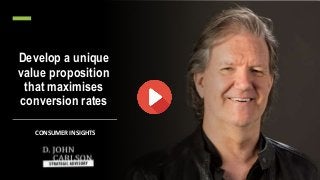
Develop a unique value proposition that maximises conversion rates.
- 1. Develop a unique value proposition that maximises conversion rates CONSUMER INSIGHTS
- 2. One of the first questions I ask a prospective client is – ‘Why would I buy your product ahead of that of your nearest competitor?’ This question asks a lot more than simply – ‘What is your value proposition?’ A value proposition is a statement of the value a product offers The reasons I might purchase one product ahead of another relates to a point of difference – a unique value proposition – one that offers tangible value to me – the purchaser.
- 3. The question - ‘Why would I buy your product ahead of that of your nearest competitor?’ is among the most important question for any business. It directly impacts conversion rates and as such: • The expenditure on generating enquiries. • The return on that expenditure generating enquiries • The return on the sales efforts – and - • Ultimately sales and profitability.
- 4. More often than not, the responses I get to this question from prospects amount to – better service or superior quality. The problems with responses of this type are: • The qualitative nature of words like ‘better’ and ‘superior.’ • The intangible nature of words like ‘service’ and ‘quality.’ • The fact that anybody can, and most do, say such things. • The reality that such claims have diminishing credibility.
- 5. The answer to the question ‘Why would I buy your product ahead of that of your nearest competitor?’ should ideally be: • Concise and easy to articulate and understand. • Entirely relevant to customer needs and wants. • Unique to the business and or its product. • Tangible and demonstratable to the customer. • Sustainable and, as such relevant over time. • Related to a factor or factors other than price.
- 6. In my experience, too few businesses devote enough time and expertise to answering the question - ‘Why would I buy your product ahead of that of your nearest competitor?’ Too few businesses spend the time understanding their market, understanding their competition, understanding their product and then refining their product to a point where the answer to this question is clear and marketable. This results in higher marketing costs and lower sales.
- 7. Examples of poor ‘points of difference’ include: • We offer the best value for money. • We offer a more reliable product. Assuming they are true, can be demonstrated and are in line with customer needs - better alternatives might include: • Our product has 20% more capacity for the same outlay. • We offer a lifetime guarantee and free service for 10 years. Being relevant to customer needs is, of course, critical if conversion rates are to be maximised.
- 8. THE INSIGHTS 1. Look beyond your value proposition to a unique and tangible point of difference. 2. Place the highest possible priority on conversion rates as a key to maximizing the return on marketing expenditure. 3. Don’t tender for business or engage in the sales process until a unique tangible point of difference is established.
- 9. To find out more - visit... www.djohncarlsonesq.com Or email me at... johnc@djohncarlsonesq.com
